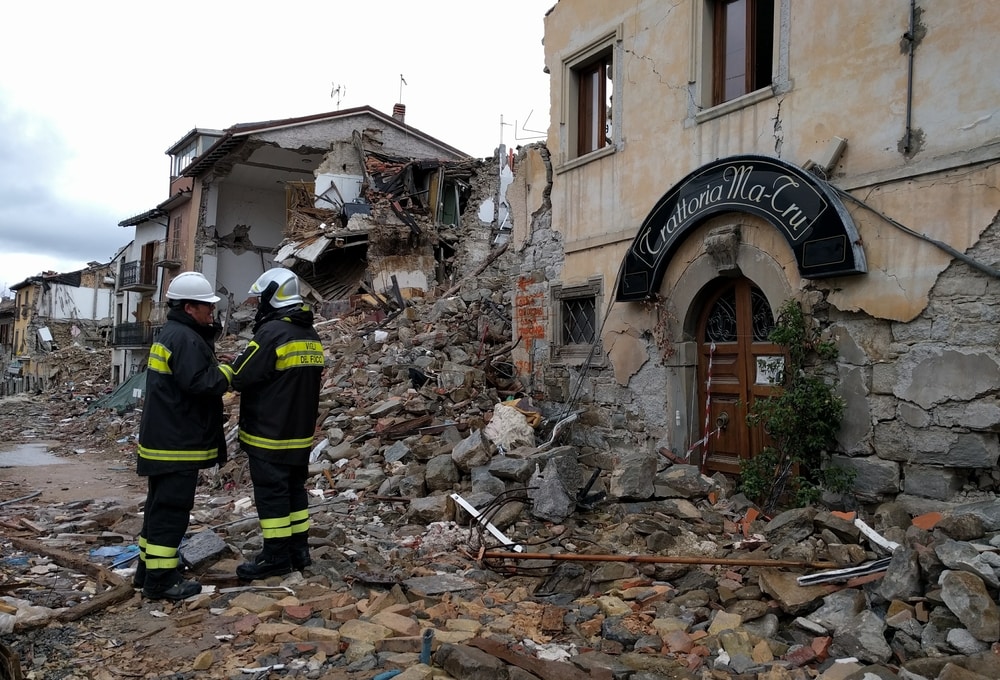
South-eastern Europe is the continent’s most seismically active region, with Greece, Italy and Turkey often experiencing the most frequent and strongest earthquakes. Greece and Italy currently have no operational government-supported country- or region-wide warning systems in place.
Central Italy in particular regularly experiences earthquakes, with the most notable recent one the earthquake in August 2016 killing nearly 300 people.
In the paper, published in Nature Communications, researchers from University College London and the European Centre for Training and Research in Earthquake Engineering (EUCENTRE), based in Pavia, find that an earthquake early warning system, similar to those used in countries including the USA and Japan, could give over 10 seconds of warning time at various locations across Europe.
Drop, cover and hold on
An earthquake early warning system consists of sensor networks and mathematical models for detecting earthquakes in real time and warning affected areas before ground shaking reaches them. The ability to warn target sites before tremors begin, even if only by a few seconds, can buy valuable time to reduce damage, accidents and fatalities.
More specifically, users can use this alert time to adopt the widely recommended “drop, cover and hold on” actions, evacuate hazardous buildings or move to safer locations within them to reduce the likelihood of injuries and fatalities.
Lead author Gemma Cremen (UCL Civil, Environmental & Geomatic Engineering) said: “A country-wide alert system would give people a few precious seconds to mitigate the potentially damaging effects of earthquakes. This warning time can enable many types of automated actions, such as stopping elevators at the nearest floor and opening the doors; slowing high-speed trains to avoid accidents/derailments; turning traffic lights red and preventing cars from entering unsafe structures such as bridges and tunnels; shutting down gas pipelines to minimise fire hazards.”
Low-amplitude tremors
The authors analysed data from 2,377 sensor stations already in place, looking at their location and the time between initial, fast-travelling but low-amplitude tremors and the major waves that cause damage and injury. From this, they calculated the amount of warning time that might be possible at each location, the expected level of shaking, and how many people would be affected by the earthquake.
This information, together with an estimate of the accuracy of the warning, led to a new indicator for the potential usefulness of earthquake early warning across Europe.
In order for a large-scale earthquake early warning system to be implemented, the already-existing sensor stations in Italy and Greece would need to be upgraded to be able to effectively and quickly transmit the relevant information, which is then used to predict the strength of the earthquake, its epicentre and how much shaking it will cause in a certain area. These predictions are made based on the first, fast waves that come through.

“The most important component of an earthquake early warning system is a dense network of sensors with fast and robust communication infrastructure. Thanks to technological advances, it is now possible to install many low-cost seismic sensors and upgrade existing ones cheaply, thus making early warning systems a very useful risk mitigation measure economically sustainable”, said co-author Elisa Zuccolo (EUCENTRE).
Such a system would also require a set threshold based on the level of shaking predicted, above which an alert is issued. This would avoid unnecessary panic and economic loss where the level of shaking is minimal and causes no damage.
False alarms
Co-lead author Carmine Galasso (UCL and Scuola Universitaria Superiore IUSS Pavia) said: “It is important to remember that an earthquake early warning system always involves some uncertainty due to the real-time process used to estimate the earthquake characteristics. Some applications may produce significant economic losses if a false alarm occurs, eventually affecting communities.
“There is a complex trade-off between the potential costs of false (and missed alarms) and the available warning time. Predictions will improve as the seismic network gathers more data on the ongoing earthquake, but the time until shaking at the target site will decrease. This short warning time means that automated decisions and mitigation actions are generally preferred.”
Risk-based predictions
Earthquake early warning systems alone are not enough to minimise damage. Building codes and standards used for bridges, railways and other infrastructure need to have earthquake-resistant clauses to ensure they are resilient enough to withstand shaking. The success of a system would also depend on people being educated on what action to take if a warning is received.
They developed a novel framework that uses advance risk (engineering)-based predictions and accounts for unavoidable malfunctions (i.e., false alarms) to determine whether or not earthquake early warning alerts should be triggered for an incoming earthquake. This method, which could be packaged as a plug-in to existing earthquake early warning platforms around the world, maximises the potential of earthquake early warning as a credible tool for promoting seismic resilience.
(Photo’s: Damage immediately after the earthquake in Amatrice (2016) and reconstruction work at the same site in 2020)
Also interesting: animals can feel an earthquake before it takes place
Selected for you!
Innovation Origins is the European platform for innovation news. In addition to the many reports from our own editors in 15 European countries, we select the most important press releases from reliable sources. This way you can stay up to date on what is happening in the world of innovation. Are you or do you know an organization that should not be missing from our list of selected sources? Then report to our editorial team.
